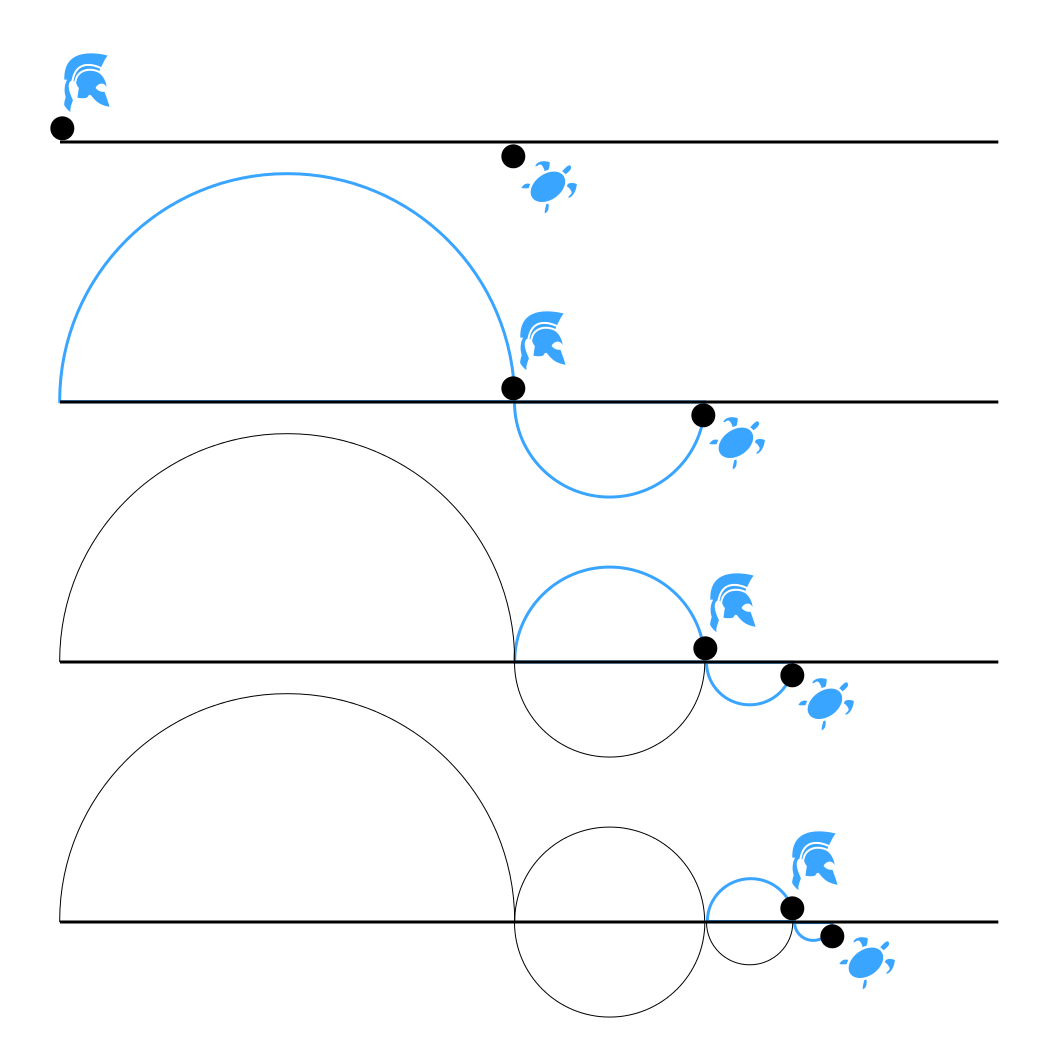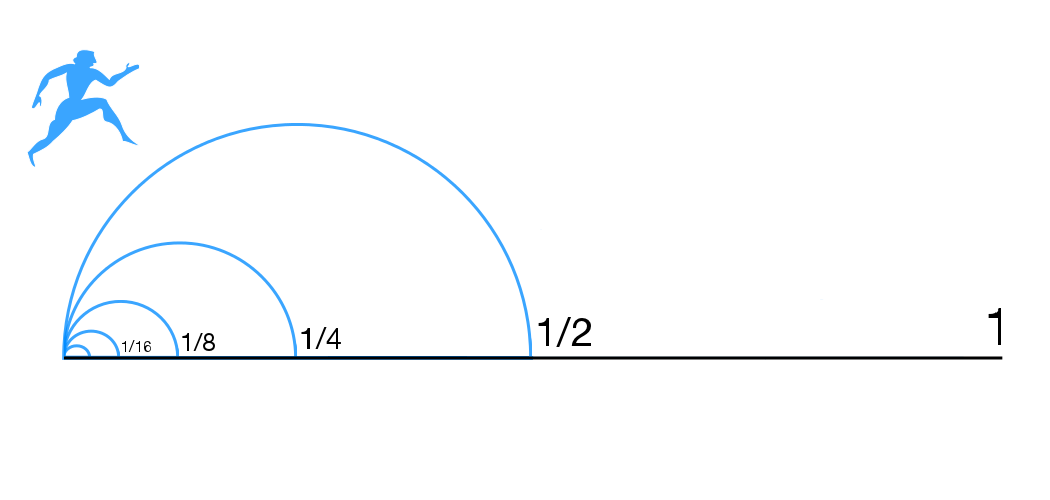- Our quiz: knot identification
Oops! Sorry folks, I must have left your quizzes at home....:(
- For today: I need your one-paragraph description of your
project and a one paragraph description of your logo;
I want to make sure that everyone has something to
share on the following Monday and Tuesday - Logo and
Project days!
I'll collect those now....
- This week's quiz will be over knot/link identification (can you draw any of our knots or links?), as well as Hilbert's Hotel, which we'll learn about today as we come to grips with infinity.
- We practiced a new way to draw the toroidal knots; hopefully you
now have a method for drawing any knot or link in our collection.
Clearly, though, some of you are still struggling with overs and unders. You have to show the bridges!
- We continued our discussion of tricolorability: "once
tricolorable, always tricolorable" is a rule.
- Thus we learned that the unknot and the trefoil must be
different knots, because one is tricolorable and the other
isn't.
Among our collection of knots and links, only the trefoil and the unlink are tricolorable.
- We discussed a method for exhaustively concluding whether a
knot is tricolorable or not: you try to continue with one color
as long as possible, and then, if that fails (leads to
non-tricolorability), switch to a second color -- and then you
can often "follow your nose" to discover whether the knot or
link is tricolorable or not.
Let's do one more example (or a few) from our Tricolor These Handout: just two of the knots/links are not tricolorable; all the rest are!
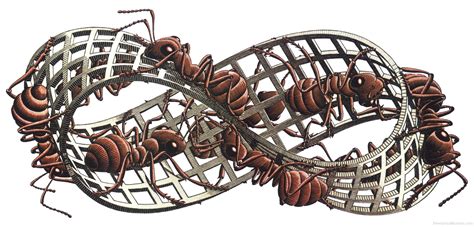
- What does this line from Amazing Grace's
sixth stanza have to do with class today?
When we've been here ten thousand years...
bright shining as the sun.
We've no less days to sing God's praise...
than when we've first begun.
John Newton 1725-1807 (stanza 6 Anon); here's the Snopes fact-checked story of the author, a slave trader.
- I've shared another hymn: In the bulb there is a flower. Last time
I shared it was because of its connection to fractals, in verse 1:
In the bulb there is a flower, in the seed, an apple tree, in cocoons, a hidden promise: butterflies will soon be free! In the cold and snow of winter there's a spring that waits to be, unrevealed until its season, something God alone can see.
Verse 3 introduces us to our topic today:In our end is our beginning, in our time, infinity; in our doubt there is believing, in our life, eternity, in our death, a resurrection, at the last, a victory, unrevealed until its season, something God alone can see.
- One more, this time from Lewis Carroll:
"Alice laughed. 'There's no use trying,' she said. 'One can't believe impossible things.'
I daresay you haven't had much practice,' said the Queen. 'When I was your age, I always did it for half-an-hour a day. Why, sometimes I've believed as many as six impossible things before breakfast."
-
Infinity! A really big idea.... It might even "blow your mind", as it
may have for Georg
Cantor, the mathematician who introduced us to many
of the ideas we'll talk about today.
- Infinity in the past: the Greeks were puzzling over infinity
thousands of years ago. One fellow in particular, named Zeno of Elea,
introduced some really paradoxical ideas: Zeno's
paradoxes. I want us to think about two of them:
- Infinity on the playground: Did you ever get into that fight on
the playground, about how much you hate someone?
- "I hate you."
- "I hate you twice as much as you hate me!"
- "I hate you twice what you hate me, plus one!"
- Eventually it gets to infinity, right?
- Infinity is NaN: Not a Number
Natural numbers are things which have a size, and if you add one to a natural number, you get a bigger number.
You don't get "a bigger number" -- more hate -- when you hate someone "infinity plus one".
In part because you don't have a number to begin with; but trying to add a number (1) to NaN doesn't work to give you a bigger number.
- Infinity is NaS: Not a Size, either! The reason is that there
is more than one size of infinity! This is the most
important thing I want you to remember. (This fact will allow
you to win on the playground!;)
- The natural numbers are infinite in number (the size of the set is
larger than any natural number). It is called a countable
infinity, because, well, we can start counting it! (We just
never get to the end).
- What is Cardinality? It is the way that we measure
infinite sets:
- Two sets have the same cardinality if there is a one-to-one correspondence between them.
Intuitively: We will say that two sets have the same size if they have the same cardinality.
- We'll look at three curious problems, about something
we'll call "Hilbert's
Hotel" (I usually call it "Motel $\infty$" -- but
I can see why mathematicians would like to honor David
Hilbert: he supported Cantor when he was proposing
and trying to defend these "big ideas").
And there's the fact that Hilbert himself introduced the analogy of the infinitely roomed hotel...:)
- Hilbert's Hotel: "it's always booked solid, but there's always a vacancy."
- Hilbert's Hotel and the Really Big High School Band
- Hilbert's Hotel and the Really Big Really Big High School Band Competition (RBRBHSBC)
- So we now begin considering "The Hilbert Hotel". The Hilbert Hotel
has natural numbered hotel rooms -- there's an infinite number
of rooms, labelled 1, 2, 3, 4, .... for every natural number.
- The place is packed, and one person shows up;
This result informs us that when someone on the playground hollers "I hate you infinity plus 1!", they really haven't hated any more than a simple infinity.
Alternatively, if your lover says they love you infinitely much, you can't impress them by saying that you love them infinitely plus one. They will scoff, and perhaps leave you for a better mathematician! So take note....
- The place is packed, and an infinite school bus shows up.
This result informs us that when someone on the playground hollers "I hate you 2*infinity!", they really haven't hated any more than a simple infinity.
- The place is packed, and an infinite number of infinite
school buses show up! (Buses numbered 1, 2, .... with
seats labelled 1, 2, ....)
This result proves that there are just as many rational numbers (ratios of integers) as there are integers.
- But if a bus containing the irrational numbers shows up -- now
there's an infinite set! It's too big for the
hotel...:( Finally the Hilbert Hotel meets its match!
The real numbers (containing both the rational and irrational numbers) is just too big for Hilbert's Hotel. Mathematicians' guts lead them to believe (generally) that the real numbers are the next largest infinity (the first "uncountable" one).
- The Hilbert Hotel shines a light on a strange fact about infinity:
that when you get to sets that are infinitely sized, you find that
their subsets can be exactly the same size as they are. This is
very strange, and doesn't work with finite sets. So it's a very
mysterious property for those of us accustomed to working with finite things....
- The place is packed, and one person shows up;
- Here's the upshot of what Cantor discovered:
- Some mathematical facts:
- Mathematical fact zero:
- A set S is just a collection of objects; and a
subset of S is just what you'd expect: some members of
S. It may be all the members, in which we call it an
"improper" subset, or it may be none of them (in which
case we call it the empty set).
We often denote a set by using braces, e.g. \(S=\{1,2,3\}\) is the set of the first three natural numbers.
We say that \(a\) is an element of \(S\) if \(a\) is contained in \(S\), and we write \(a \in S\). So \(1 \in S\), \(2 \in S\), and \(3 \in S\). We deny that an object is in \(S\) this way: \(4 \notin S\).
- Mathematical fact one:
- A subset is never bigger in size than the set itself.
And if the sets are finite, the proper subset is always smaller, but if the set is infinite, we may actually be able to throw away elements of a set and not change the size of the set!
- Mathematical fact two:
- Let's call the set of all of a set S's subsets its
power set, \(P(S)\). Pascal's triangle (that rascal!)
shows you how many of each type of subset you have (for finite
sets). Let's look at "line 3" (that is, 1 3 3 1):
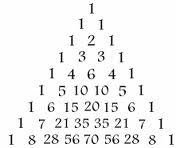
It's about how many ways we have of choosing \(r\) things from \(n\), right? That's exactly what a subset of \(r\) elements is: a choice of \(r\) things from \(n\). Here are the four different groups of subsets represented by that line:
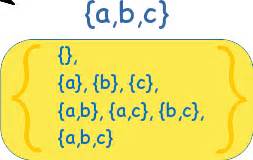
- Mathematical fact three:
- The power set of a set of $n$ elements contains $2^n$
elements.
Imagine that each of the \(n\) elements is a person, who decides if they're going to stand up and join a subset, or not. Each person has two choices, and they make them independently. Thus we have \(2 \cdot 2 \cdot \ldots 2\) -- \(n\) times -- ways of making a choice of a subset, of choosing.
(We know that since each row of Pascal's triangle adds to a power of 2, and the elements in each row represent all the different subsets of each size possible, from 0 up to \(n\).)
- Mathematical fact zero:
- Even the set containing no elements has one subset -- the set
itself. So the power set has one element -- has size bigger
than the set itself.
This property holds true for all finite sets -- and it turns out to be true for infinite sets, too!
Here's a silly video to illustrate how the power set grows with sets of increasing size. (Thanks to Dr. Towanna Roller (Asbury University) and her daughter Kristyn Roller (UK) for this one!)
- This means that, although the natural numbers $1,2,3,\ldots$ is
infinite as a set, there's a bigger set (the power set of the
natural numbers).
And the power set of that set is bigger yet, and so on forever, forever, Hallelujah, Hallelujah!
-
Upshot: infinity comes in various sizes! Infinitely
many, in fact. Crazy sounding, I know -- but it's true.
That symbol that you've been familiar with for all your lives, $\infty$: you thought it stood for a single thing; but it stands for a whole collection of monstrously big things, all too big to really think about properly. (Well, Cantor did!:)
- That's too crazy, it seems; but, nonetheless, mathematicians
know that it's true, because we can prove it! The key to
determining if two sets have the same size is the one-to-one
correspondence -- and that is key for infinite sets, as well.
- So, in the end, here's what you say on the playground,
when you want to love your friend more:
"I love you more than the power set of your set of infinite love."
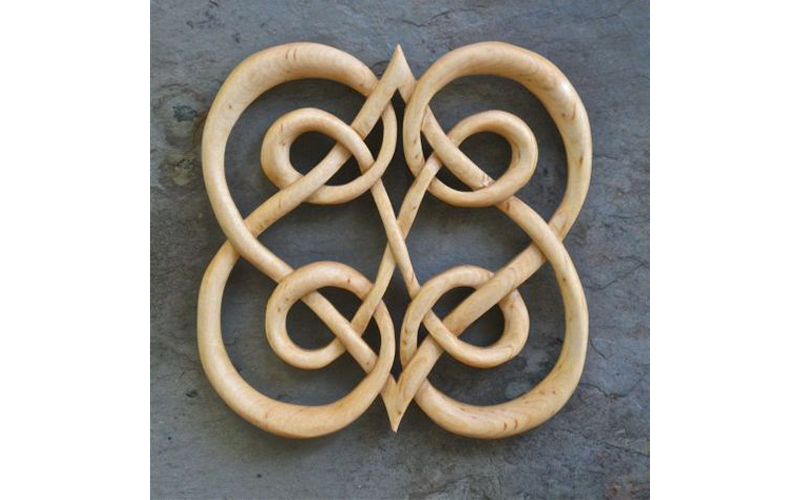
Amen!
- Some mathematical facts:
- My collection
of knots and links
- My Borromean knots (and links)
- Tricolor These Handout: just two of the knots/links are not tricolorable; all the rest are!
- A much more thorough introduction to both Reidemeister moves and tricolorability is in this article: Tricolorability of Knots, by Kayla Jacobs.
